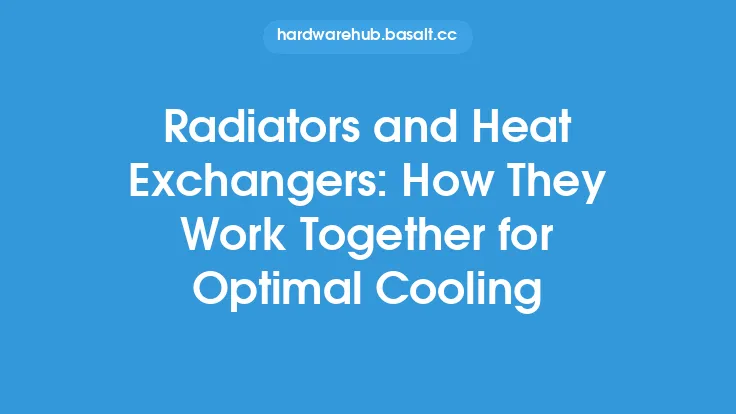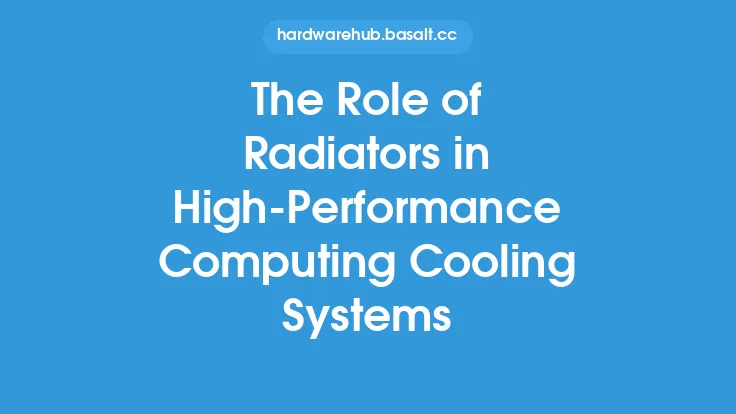The manufacturing of radiators and heat exchangers involves a variety of materials and processes, each with its own unique characteristics and advantages. The choice of material and manufacturing process depends on the specific application, operating conditions, and desired performance of the radiator or heat exchanger. In this article, we will explore the different materials and manufacturing processes used in the production of radiators and heat exchangers, highlighting their strengths and weaknesses, and discussing the latest trends and developments in the field.
Introduction to Materials
The materials used in the construction of radiators and heat exchangers play a crucial role in determining their performance, durability, and overall efficiency. The most common materials used are metals, such as copper, aluminum, and steel, which offer high thermal conductivity, corrosion resistance, and mechanical strength. Copper, in particular, is widely used due to its excellent thermal conductivity, which allows for efficient heat transfer. Aluminum, on the other hand, is often used in applications where weight reduction is critical, such as in automotive and aerospace industries. Steel is commonly used in industrial applications, where high pressure and temperature resistance are required.
Manufacturing Processes
The manufacturing process of radiators and heat exchangers involves several stages, including design, prototyping, and production. The most common manufacturing processes used are brazing, welding, and soldering, which allow for the joining of different components and materials. Brazing, for example, is a high-temperature process that uses a filler material to join two metals, resulting in a strong and leak-tight joint. Welding, on the other hand, uses heat and pressure to fuse two metals together, creating a strong and durable bond. Soldering, a lower-temperature process, is often used to join smaller components, such as tubes and fins.
Tube and Fin Manufacturing
Tube and fin manufacturing is a critical process in the production of radiators and heat exchangers. The tubes, typically made of copper or aluminum, are used to carry the fluid, while the fins, usually made of aluminum or steel, are used to enhance heat transfer. The tubes and fins are manufactured using various processes, including extrusion, drawing, and machining. Extrusion, for example, involves pushing the material through a die to create the desired shape and size. Drawing, on the other hand, involves pulling the material through a die to create a specific shape and size. Machining, a more precise process, involves using cutting tools to create the desired shape and size.
Plate-Type Heat Exchangers
Plate-type heat exchangers are a popular design, offering high heat transfer rates and compact sizes. The plates, typically made of stainless steel or titanium, are stamped or machined to create a specific pattern, allowing for efficient heat transfer. The plates are then assembled into a frame, using gaskets or welding to seal the joints. Plate-type heat exchangers are widely used in various applications, including HVAC, industrial processes, and power generation.
Corrosion Protection and Coatings
Corrosion protection and coatings play a critical role in ensuring the longevity and performance of radiators and heat exchangers. The most common corrosion protection methods used are painting, coating, and plating. Painting, for example, involves applying a layer of paint to protect the surface from corrosion. Coating, on the other hand, involves applying a layer of material, such as epoxy or ceramic, to protect the surface from corrosion. Plating, a more advanced process, involves depositing a layer of material, such as chrome or nickel, onto the surface to provide corrosion protection.
Quality Control and Testing
Quality control and testing are essential steps in the manufacturing process of radiators and heat exchangers. The most common tests used are pressure testing, leak testing, and performance testing. Pressure testing, for example, involves subjecting the radiator or heat exchanger to high pressure to ensure its integrity. Leak testing, on the other hand, involves using gases or liquids to detect any leaks or defects. Performance testing, a more comprehensive test, involves measuring the heat transfer rate, pressure drop, and other performance parameters to ensure the radiator or heat exchanger meets the required specifications.
Advances in Materials and Manufacturing
The field of radiators and heat exchangers is constantly evolving, with advances in materials and manufacturing processes. The use of new materials, such as nanomaterials and composites, is being explored, offering improved thermal conductivity, corrosion resistance, and mechanical strength. Additive manufacturing, also known as 3D printing, is also being used to create complex geometries and structures, allowing for improved heat transfer rates and reduced material usage. Additionally, the use of simulation tools and modeling software is becoming increasingly popular, allowing designers and engineers to optimize the design and performance of radiators and heat exchangers.
Conclusion
In conclusion, the manufacturing of radiators and heat exchangers involves a variety of materials and processes, each with its own unique characteristics and advantages. The choice of material and manufacturing process depends on the specific application, operating conditions, and desired performance of the radiator or heat exchanger. By understanding the different materials and manufacturing processes used, designers and engineers can create efficient, reliable, and cost-effective cooling systems. As the field continues to evolve, advances in materials and manufacturing processes will play a critical role in shaping the future of radiators and heat exchangers.





